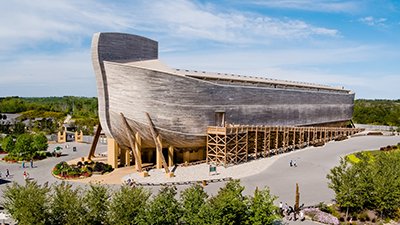A Cincinnati Enquirer Ark Hit Piece
We are rejoicing in the tremendous amount of media coverage the Ark Encounter is already receiving two weeks before the July 7 opening in Northern Kentucky (south of Cincinnati). For example, many media reports this week led to the Ark trending number one on Facebook a few times! Even the liberal TV network CNN carried a couple of Ark stories this week, with its anchor/reporter (who toured the Ark) describing the huge ship as “magnificent,” “awe inspiring,” “mind blowing,” and “remarkable.” I wish to add that, although the CNN reporter was tremendously impressed by the engineering and architectural marvel that the Ark is, she still brought up the old church-state issue that a federal court dealt with last January as a judge handed Answers in Genesis a victory in court against the state of Kentucky for unlawful religious discrimination.
Along with the generally positive and balanced news coverage we have enjoyed, now comes a recent, glaring exception. It’s from our hometown newspaper, the Cincinnati Enquirer. Two articles about the Ark have appeared on the Enquirer website (and perhaps others to follow). Because the paper is a part of the Gannett network, other papers like USA Today will be carrying one or both of the Ark articles. Sadly, the myths found in the articles will see a wide distribution.
It’s become obvious to us over the years that changes within the leadership of the Enquirer have given rise to an increasingly liberal viewpoint among its editors and reporters. While we have appreciated the fair coverage that we have received about our Creation Museum and Ark Encounter, the June 23 article on our Ark Encounter revealed the growing bias the paper has against those of us who embrace biblical Christianity. Here are just some of the misrepresentations and outright falsehoods found in the Enquirer article.
Misleading Headline
It is startling that the writer or headline writer would create such a highly misleading headline.
First, there’s the original headline: “Who Pays for the New Ark? Taxpayers.” Now, in the latest web version circulating on the Internet, the title has been slightly altered (after we protested) to “Who Pays for the New Ark? Taxpayers Help.” Even with that Band-Aid, and after years of the Enquirer being shown the facts regarding the Ark’s funding, it is startling that the writer or headline writer would create such a highly misleading headline.
Misinformation on Funding
Bonds and Rebates
For the umpteenth time, I need to say that taxpayer/public funds have not been used in any way to fund the construction of our life-size Noah’s Ark opening July 7 in Williamstown, about 40 miles south of Cincinnati. All funds (i.e., bonds and donations) to build the Ark Encounter came from private supporters of the Ark project. Furthermore, the bonds purchased by our private supporters were nonrated bonds that were collateralized with a first mortgage on the Ark real estate and a pledge of project revenues, unlike the writer’s claim that these were “junk bonds” with no security. In fact, today there are several billion-dollar municipal bond funds that hold a significant amount of nonrated bonds that perform well.
The writer’s statement that the Ark Encounter “landed a series of local and state incentives worth $80 million over 20 years” is just flat out wrong. Yes, the Ark Encounter has the opportunity through Kentucky’s tourism incentive program to receive a future rebate of sales taxes that it generates at our theme park, up to $18.25 million over a 10-year period after it opens (and as the writer did correctly state, the right of the Ark Encounter to participate in this program was upheld in federal court last January; see “Victory for AiG/Ark Encounter in Federal Court” for more background).
Ultimately, only visitors to the Ark Encounter pay the sales tax that generates the possible rebate, which is a performance-based rebate incentive that does not come from any other source or taxpayer funds. So when the reporter wrote that "the ark project is a lightning rod for its reliance on public tax incentives,” he is just flat out wrong.
When you combine the Ark and the Creation Museum, the estimated economic impact in the state over the next ten years should be at least $4 billion. More than 20,000 jobs will be directly and indirectly created. Just at the Ark alone, 350 new staff for phase one of the Ark Encounter have been, or are in the process of being, hired. As the theme park expands over the years, hundreds more will be employed. Most jobs to be created will be in the community and thus outside the Ark Encounter.
As we often speak to civic groups and churches, we have made this pledge to Kentuckians: AiG will promote the many excellent attractions throughout our state, plus in Cincinnati. To help boost tourism for the entire region, we have announced the creation of a seven-day pass to visit both the Ark and the museum. This special pass will encourage visitors to make Kentucky their vacation destination. So rather than just staying two or three days, visitors will take in the other attractions over several days. We are now getting Facebook comments like: “Well my family vacation this year is going to be a week in Kentucky. Solely because of the Ark.”
The state’s treasury will see millions of dollars added through sales tax collected at Ark-related businesses, as well as through state income tax collected from new jobs created that are associated with the Ark. So while we point out that not one penny has come from the state to build the Ark, even after a tourism incentive goes into effect, the net gain to the state’s treasury will be enormous. This influx would not have been possible for Kentucky if the Ark had been built in Indiana, which also courted us.
TIFs (Tax Increment Financing)
Tax increment financing (TIF) is a tool to encourage new development and redevelopment. It allows local governments (and sometimes states) to capture the increases in taxes from a designated area (TIF district) generated by new development within the TIF district, and to use a portion of those increased taxes to encourage the new development or improvements within the TIF district. It is an incentive program that is widely used throughout the United States. Across Kentucky, several cities have used a TIF for landmark developments to facilitate new development, expansion, and renovation in their communities. These projects include Yum Arena, the Louisville Marriott Hotel, the downtown Bowling Green Project, and the 21c Lexington Hotel. Key projects in Northern Kentucky that have used TIF include Manhattan Harbour, Ovation, the Fort Mitchell Gateway Project (redevelopment of Drawbridge Inn site), and Ark Encounter.
The city of Williamstown established an 898-acre TIF district to provide local incentives to Ark Encounter and other projects that may develop as a result of the Ark Encounter project. (Ark Encounter will only receive TIF district incentives from the taxes generated on the property that it owns and develops). The city and Grant County each support projects, with the TIF district providing a pledge of 75% of the new incremental increase in real estate taxes for a 30-year period. No existing taxes were impacted.
At the time the TIF district was established, the total taxable assessment of the 898-acre district totaled only $3.89 million, and it produced $5,611 in county taxes and $10,662 in city taxes. Ark Encounter will increase the taxable assessment of the TIF district by over $75 million dollars. Even with the 75% increment of the city and county taxes pledged to Ark Encounter, the city and county will annually generate thousands more in taxes than they would have if Ark Encounter had not been built. The net annual increase in new taxes to the city will be $58,125, and to the county will be $27,375, and these amounts do not include the increased amounts from tangible property taxes or other taxes the city and county will receive.
The local taxing entities over the life of the TIF will generate millions in new taxes as a result of Ark Encounter.
In addition, the other local taxing districts in Grant County—schools, library district, and so on—will receive 100% of the increased taxes as those taxes are not pledged to the TIF district. Therefore even though some of the increased taxes will be used to reimburse the Ark Encounter for its capital costs, the local taxing entities over the life of the TIF will generate millions in new taxes as a result of Ark Encounter, to the great benefit of Grant County residents.
Mistaken Quotation
Finally, there is an error in regard to a comment reportedly made by Bill Nye “the Science Guy,” quoted by the Enquirer in a second Ark-related article. Mr. Nye, who debated me two years ago on creation and evolution in the Creation Museum, apparently told the Enquirer reporter via an email that “he wasn’t allowed to see the entire museum but that what he saw was ‘troubling.’”
Not only was he allowed to tour the museum, we actually reached out to him twice to visit! We told Mr. Nye’s publicist, Nick, in New York a few weeks before the debate, to indicate that I would be personally willing to show Nye through the museum. When we discovered that Mr. Nye would be arriving in our Cincinnati area several hours before the debate, we sent an email to his assistant, Christine, on February 3, 2014 (a few days before the debate). We reminded Mr. Nye of my invitation to tour the museum before the debate: “If Mr. Nye wants to tour the museum, you need to plan on being here before that time (no later than 5:00 p.m.).”
The Enquirer further reported that Nye said,
It’s important to note also that this is not a museum as such. . . . There are no artifacts. It’s a series of exhibits with models and mannequins depicting a world that never existed; the displays are completely inconsistent with what we know of the ancient Earth.
How would he really know if he didn’t tour the museum, as we twice encouraged him to accept my offer to personally show him through the exhibits as a gesture of goodwill?
Moving Forward
The Ark Encounter will support several thousand jobs directly and indirectly in the region and bring millions of dollars in economic activity and new tax revenue to Kentucky. And even though it’s certainly disappointing to see this terrible Enquirer/Gannett piece with numerous misrepresentations that attack our privately funded, family-friendly theme park, all of us at AiG and our 43,000 Ark donors worldwide (in 40 nations) are excited about the positive impact the Ark Encounter will have on the region. The voyage beings again, July 7! See ArkEncounter.com to plan your visit.

Answers in Genesis is an apologetics ministry, dedicated to helping Christians defend their faith and proclaim the good news of Jesus Christ.
- Customer Service 800.778.3390
- Available Monday–Friday | 9 AM–5 PM ET
- © 2026 Answers in Genesis




